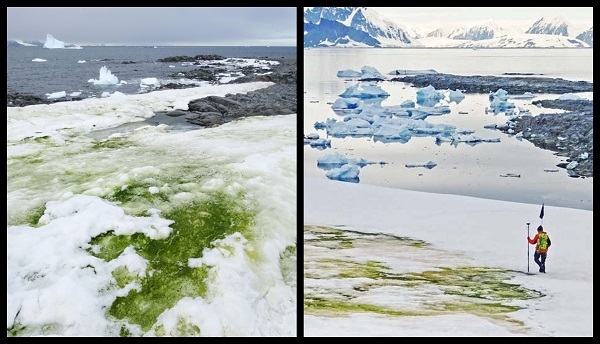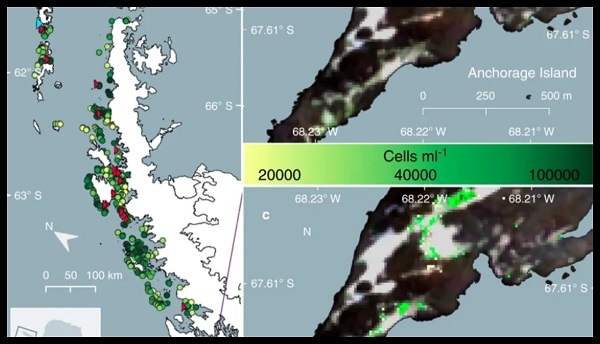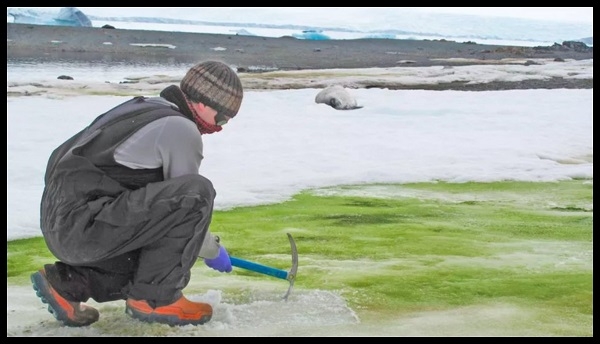Snow Is Turning Green in Antarctica!
22 May 2020 13:56:56
Antarctica, May 22: In a major development, the color of snow in Antarctica is changing. As the global temperature is rising exponentially on the earth, Snow in coastal Antarctica is turning green. It has become so prolific in places that it is even visible from space.

The green snow algae are microscopic organisms when measured individually but when the organisms grow simultaneously, they turn the snow bright green and can even be spotted from space, researchers said in a study published in the Nature Communications journal on Wednesday, May 20.
The snow around the #Antarctica coastline is turning green – and it's visible from space!
— Cambridge University (@Cambridge_Uni) May 21, 2020
Researchers combined European Space Agency @esa satellite images with their own measurements on the icy continent to find out what's going on.#SustainableEarth pic.twitter.com/8Fixcajvka
The researchers used satellite images from the European Space Agency taken between 2017 and 2019, and combined those with observations they made themselves in a trip to Antarctica’s Ryder Bay, Adelaide Island, the Fildes Peninsula, and King George Island.

“This is a significant advance in our understanding of land-based life on Antarctica, and how it might change in the coming years as the climate warms,” said Dr. Matt Davey in the University of Cambridge’s Department of Plant Sciences, who led the study. “Snow algae are a key component of the continent’s ability to capture carbon dioxide from the atmosphere through photosynthesis.”
Blooms of green snow algae are found around the Antarctic coastline, particularly on islands along the west coast of the Antarctic Peninsula. They grow in ‘warmer’ areas, where average temperatures are just above zero degrees Celsius during the austral summer - the Southern Hemisphere’s summer months of November to February. The Peninsula is the part of Antarctica that experienced the most rapid warming in the latter part of the last century.
The researchers identified 1,679 snow algae that covered up to 1.9 square kilometers at the height of summer when the blooms are largest. Two factors seemed to determine where the blooms were: the temperature had to be warm enough for the snow to become slushy and there had to be a source of nutrients – mostly penguin guano.
“We identified 1679 separate blooms of green algae on the snow surface, which together covered an area of 1.9 km2, equating to a carbon sink of around 479 tonnes per year” said Davey.
They also found that the majority of algae blooms were within five kilometers (three miles) of a penguin colony, as the birds' excrement is an excellent fertilizer. The team calculated that algae on the peninsula currently absorb levels of CO2 equivalent to 875,000 average car journeys. Over 60 percent of the blooms they mapped were found within three miles of penguin colonies, and blooms were also often observed near where birds nest and seals hang out on the shore.

Almost two-thirds of the green algal blooms were on small, low-lying islands with no high ground. As the Antarctic Peninsula warms due to rising global temperatures, these islands may lose their summer snow cover and with it their snow algae. However, in terms of mass, the majority of snow algae is found in a small number of larger blooms in the north of the Peninsula and the South Shetland Islands, in areas where they can spread to higher ground as low-lying snow melts.
Scientists have previously observed a change in green lichen and moss, but these grow extremely slowly compared with algae. In the future, they will also measure red and orange algae and calculate how the presence of such colorful forms might be affecting the heat-reflecting albedo quality of the snow.
“I think we will get more large blooms in the future. Before we know whether this has a significant impact on carbon budgets or bio albedo, we need to run the numbers,” said Andrew Gray. They plan further work to measure these other algal blooms, and also to measure the blooms across the whole of Antarctica using a mixture of fieldwork and satellite images.
Antarctica is the world’s southernmost continent, typically known as a frozen land of snow and ice. But terrestrial life can be abundant, particularly along its coastline, and is responding rapidly to climate changes in the region. This new study has found that microscopic algae also play an important role in Antarctica’s ecosystem and its carbon cycling.